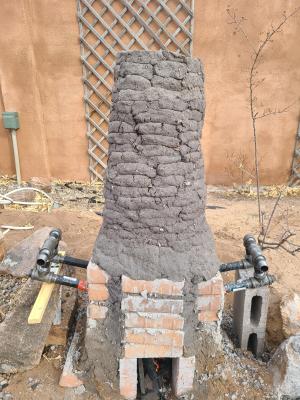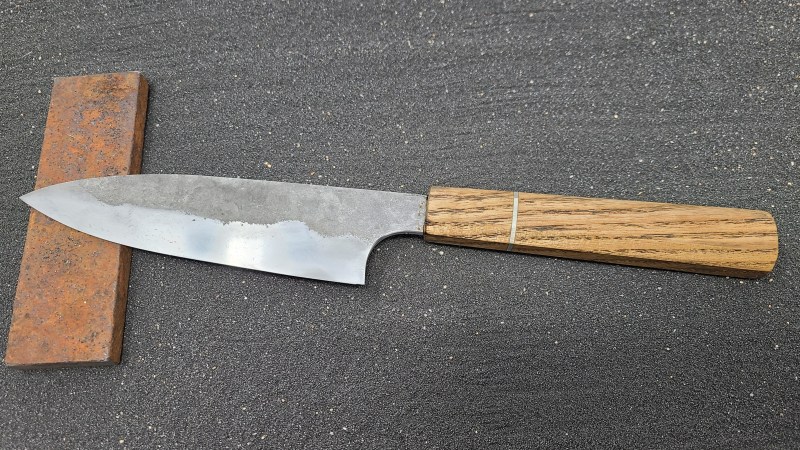Some people order their raw materials from a factory, missing out on 99% of the fun… or suffering, we’re not sure which. To make that call, you need to look in on the process [IllyriaD] used to collect magnetite sand and turn it into a wicked-looking chef’s knife.
 This began by collecting 150 pounds (!) of magnetic dirt from dry lake beds while hiking using a magnet pickup tool with release lever that he got from Harbor Freight. Several repeated magnetic refining passes separated the black ore from non-metallic sands ready for the furnace that he built. That is used to fire up the raw materials using 150 pounds of charcoal, changing the chemical composition by adding carbon and resulting in a gnarly lump of iron known as a bloom.
This began by collecting 150 pounds (!) of magnetic dirt from dry lake beds while hiking using a magnet pickup tool with release lever that he got from Harbor Freight. Several repeated magnetic refining passes separated the black ore from non-metallic sands ready for the furnace that he built. That is used to fire up the raw materials using 150 pounds of charcoal, changing the chemical composition by adding carbon and resulting in a gnarly lump of iron known as a bloom.
From there, it’s just a matter of beating the iron bloom into submission over at the anvil. [IllyriaD] details the process of flattening it out to a bar shape, then folding it over. Seven total folds are made for 128 layers, and in the gallery there’s a fantastic image that captures the striation when viewed on end. After being sharpened and polished, you can see where the bevel descends through those layers.
It’s delightful to see people working through the old ways and proving you don’t need a factory, as long as your true goal is to explore the process itself. Does this leave you wanting even more? [IllyriaD] left some insight about the process in the comments of the reddit thread. You probably also want to check out the tile-roofed hut built by [PrimitiveTechnology] without any modern tools.
















It can also be used to building space age fabricators and housing.
https://subnautica.fandom.com/wiki/Magnetite#Uses_in_Crafting
Love this game. Can’t wait for sub-zero on my console.
Don’t get your hopes up too high… it’s got some nice features, but I felt the story wasn’t as good as the first one.
Primitive Technology did “Iron Prills” with a much smaller yield.
If you have an hour and a half you can watch the day-long traditional African method being demonstrated (with an unfortunate, annoying voice-over):
https://youtu.be/RuCnZClWwpQ
He went out and mined the ore for his project, and made his own furnace.
Can he legitimately say that his project *wasn’t* 99% collaboration, or does he still have to say he stands on the shoulders of giants?
Nobody can just think up this stuff all by themselves from nothing. A lot of people figured it out, bit by bit, over a very long period of time. Now that we know how to do it, we can replicate it with the benefit of all of that hard won knowledge.
He collaborated with many more than 99 other people in that regard, so it’s probably more like 99.999% collaboration.
Not to take away from his efforts. It’s extremely impressive that he was able to do this with so much self-sufficiency. But there _is_ a reason that people like to show acknowledgement; it’s not all political correctness.
And what would that reason be?
I’m willing to believe that there is a reason because you state that there is one – but could you enlighten us?
Have you thought through the implications of denying people a sense of quiet satisfaction from coming up with something and doing a good job?
Are satisfaction in your accomplishments and acknowledgment that others paved the way mutually exclusive?
(Expanding on the previous response question)
I understand that no one creates in a vacuum, that we all rely on the fruits of others.
What I *don’t* understand is why anyone would take the trouble to bring that up. Being true isn’t sufficient reason.
Many people suffer from lack of motivation for finishing projects, and one reason could be that everyone keeps undercutting the resultant satisfaction. Your brain is a correlation engine, and “Nice project, but others are responsible for the bulk of the work” sounds like a recipe for associating project completion with cutting critique. Keep getting accomplishments dismissed your brain will learn to correlate accomplishment with disappointment.
A little bit of pride in accomplishment is healthy. It probably triggers the dopamine hit that encourages you to have more accomplishments.
Overbearing pride, arrogance, superiority, or false accomplishments are bad obviously, but this does not mean that *all* pride is bad. Some quick googling on religious opinion bears this out.
A different way to look at this is to note that the societal structures he used were *also* available to you – except that he completed a project and you did not. Saying that he only stands on the shoulders of giants is indistinguishable from envy. (Newton said it about himself, which is quite a different thing from someone saying it about others.)
So yes, I’m wondering what the reason is. What positive reason do you have for pointing it out?
Yep.
I have a project which I did a bunch of design on, and when I showed off pieces of it (prototype circuit designs) I was accused of “repurposing others designs”. Uhm. No.
Yes, in the sense that I looked at the data sheets and provided circuits and reimplemented them into a design for showing 10 digit 7 segment displays (with low current draw), driving multi-color LEDs in a circuit I could expand to provide 150-200+ Lights and drive solenoids for flippers and bumpers….
Basically, my own circuit design for an entire pinball machine, using Arduino and Rpi as controllers.
But yeah, it’s just like that 2 LED circuit example included in the data sheet…
I work as a software developer, I know what it’s like to work on a project and take it to the 80% mark. I also know what it’s like to deliver that last 20%, it’s a lot harder than most people think.
The number of people out there today that say demotivational things, attack projects they could never understand and otherwise diminish other peoples work is disheartening.
No, I’m not growing my own silicon crystals
Well said.
It really seems to me that you’re arguing against yourself here. You’re the one who brought up how collaborative [IllyriaD] had been, don’t go off on one just because someone else joined the conversation.
Who do you acknowledge for a project like this?
And now I’m reminded of all those dedication speeches when awards are handed out. “I’d like to thank…”
If he did all the labor himself, he should pat himself on the back. It’s not easy, very few in the metal casting hobby and forging trades ever go this far.
He doesn’t need to acknowledge anyone unless they stepped up and helped him.
Very nice knife, by the way. Impressive work!
But he made it a reality and that is what matters and quite impressive for a first time at that.
In regards to collaboration, unless these people were actually advising and helping him, He can claim he did it all himself.
Of course “these people” were advising and helping him. If he were one of those Mowgli wild children he’d be able to claim he wasn’t helped by those who went before, but Mowgli wild children wouldn’t even accomplish stone hand axes. In this case [IllyriaD] has obviously become familiar with furnace and forging techniques before attempting this.
Acknowledging that you’re human and use humanity’s strongest tool, communication, is a positive thing.
Well done [IllyriaD], and thank you for documenting the process.
“…collect magnetite sand and turn it into a wicked-looking chef’s knife.” I believe the common term is “Ironsand” [1] which contains (amongst other things) the mineral Magnetite [2], an iron ore.
“Seven total folds are made for 128 layers…”; n folds results in 2^n layers. The number of folds and how the folds are done during the forging process involves both science and art.[3]
* References
1. Ironsand
https://en.wikipedia.org/wiki/Ironsand
2. Magnetite
https://en.wikipedia.org/wiki/Magnetite
3. Japanese Swordsmithing – Forging
https://en.wikipedia.org/wiki/Japanese_swordsmithing#Forging
Also, I found the terms used a little “off”. The iron that comes out of the bloomery (the “bloom”) is impure iron that’s typically called “sponge iron” and is hammered and consolidated into wrought iron – that can be used to make iron objects, and used to be a common material for blacksmiths to use. It’s not steel, it has far too much carbon to be steel. It’s also fairly impure. The method used to fold it similar to how Japanese forged blades were made can be done for the same reason… the folding homogenizes the impurities throughout the stock, which can yield a higher quality blade than simply shaping the wrought iron would permit. However, it’s still an iron blade, and it’s not “refined”. This knife took a lot of work, and it’s an impressive effort, but to be accurate he has produced a wrought iron folded blade knife which is going to be a lot softer and not stay as sharp as any modern steel knife.
“Damascus iron”? ;)
super cool and ambitious
which there were more photos /description
(but I don’t document anything – so no complaint)
And I (used to) feel smug about scrambling eggs!
There is a long and very detailed video on youtube show with Africans doing a similar thing using only traditional methods and materials. YT Search: RuCnZClWwpQ